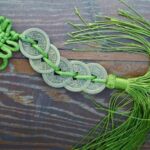Introduction to Feng Shui
Feng Shui is an ancient Chinese philosophy that has been used for thousands of years to create harmonious energy in a space. The foundation of Feng Shui is based upon the idea of qi, a form of invisible energy that flows throughout the universe. When this energy is blocked or hindered, it can create disharmony and negative chi in a person’s home or office environment. It is believed that part of this balancing process involves the placement of symbols and objects, as well as the selection of colors and textures to bring about positive chi, or luck.
Feng Shui practitioners use a variety of methods to ensure their clients experience positive energy. One popular way to channel this energy is through the use of feng shui symbols and amulets. These talismanic items represent luck, health and prosperity and promote energizing influences from nature elements like wood, fire and water. Symbols commonly used include dragons – known for their protective power – cash objects such as gold coins, Chi-Lin (the symbol for happiness) and Pa Kua (the eight trigrams). Amulets can also be used; these are typically designed with special words or mantras that help to generate fertility or wealth. Additionally, certain plants have long been associated with feng shui due to their energetic properties; bamboo, chrysanthemums, sandalwood trees and plum blossoms are common choices because they are known to attract abundance in fortune and career advancement.
Symbolism of Feng Shui
Feng Shui is a holistic tradition based on the concepts of energy, balance, and harmony. Its principles are meant to bring in positive energy, create order and symmetry, enable clarity of intent, and ensure healthy relationships between people and their environment. Feng Shui symbolism is a set of traditional Chinese symbols used as part of this practice to influence Chi (life force) into an orderly pattern conducive to desired outcomes. Typical symbols include paintings, coins, statues of animals or gods, mirrors, and Chinese characters like Fu (“good luck”), Lu (“happiness”), Shou (“longevity”), Chung (“harmony”) and Xi (“wealth”). Amulets are also used for protection from negative forces that may exist in home environments. Common amulets include charms representing the Eight Immortals, a representation of Taoist deities who are believed to have bestowed special powers upon them; pictures or statues of Kuan Yin”the Goddess of Mercy in Mahayana Buddhism; Chinese knots; bells; hexagrams (symbols with six points); scrolls with good luck phrases written on them; scissors hung with red ribbons to ward off bad luck; ducks; turtles; fu dogs”stone statues with lions’ heads often found guarding entryways or tombs; horseshoes hung upside down beneath front doors”representing catching goodness while keeping out evil spirits.
Traditional and Cultural Links to Feng Shui
Feng Shui is an ancient Chinese philosophy that works on the premise of balancing and harmonizing the energy flows found in our environment. This energy, known in traditionally Chinese as Chi, is believed to be fundamental for leading a successful life. An important part of Feng Shui is the use of symbols, charms and amulets known as ‘Feng Shui Simbolos y Amuletos’ which are believed to bring luck, wealth and protection. Feng Shui symbols have their roots in traditional Chinese culture and reflect various sub-schools within this field such as Bagua, Flying Star and Date Selection.
The most common symbols used in Feng Shui are believed to invoke or bring luck in specific areas of your life such as the traditional coin combination which is said to attract money; a pair of Mandarin ducks together which provide love and harmony; a longevity lock conferred on those born into noble families at birth that grants long life; representations of dragons which are thought to possess both good and evil forces; phoenixes signifying grace, beauty and abundance through fertility; a Fu symbol meaning prosperity; tortoises who signify positive change; the dragon turtle symbolizes independence, stability and personal success without influencing others negatively; images of Bagua enabled spaces can create favorable energies while koi fish signify fortune, strength and bravery.
These symbols have been used for generations across Chinese culture with references to many being documented in various books including ‘The Book Of Changes”, “Lao Zi’s Dao De Jing” (The Tao Te Ching) and other classical texts. While modern trends mean that some younger people may find these superstitious representations outdated there remains an appeal for all ages when it comes to bringing luck into one’s lives through modern interpretations of the classic Feng Shui motifs.
Practical Application of Amulets and Symbols
Feng Shui symbols and amulets are powerful tools for improving your living space, as well as your life. In order to maximize their positive effects, it is important to learn how to properly use them. Here are some tips on doing just that:
First, identify the areas of your home or office that require special attention. This could be energy-draining areas, such as a bedroom facing an entrance door or a workspace with negative clutter around it. Once the areas have been determined, you can start looking for the right symbols and amulets that have energies that can help with these specific issues.
Second, research ways of harnessing each amulet’s power. Some items have specific connotations associated with them; for example, dragon imagery symbolizes zeal and bravery while Buddhas with open palms represent physical health and wellness. Researching each symbol helps you better understand its benefits and how to use it in your own space.
Third, keep in mind that the placement of amulets is essential to bring about beneficial results. Symbols should be placed in areas that affirm balance or in locations where blocked Qi needs to be restored (such as at intersections of walls). Additionally, symbols should not be placed too high; they should hang at just above eye level or four feet off the ground”any higher would put them out of balance.
Finally, think before you act. Amulets and symbols do bring good energy into any space however they need regular blessing and cleansing from time to time in order to keep their positive energies intact
Combining Feng Shui Amulets with Other Practices
Feng Shui Symbols and Amulets are an ancient practice which can be used to help create harmony and balance within a space. Symbolically, these amulets each carry a distinct energy or meaning which sets the mood of the entire environment. Traditionally, Feng Shui implies utilizing the five element theory, providing each area with the right amount of natural elements such as water, wind, fire, trees, or even animals in order to facilitate balance. The placement of symbols and amulets is also key in creating this sacred balance by amplifying either positive or negative energy depending on their purpose. These pieces can symbolically represent wealth, luck, physical health, emotional fortitude and spiritual growth among others. To further unify holistically all aspects of nature it is recommended that a person may combine this practice with other practices such as yoga and meditation one may find beneficial for maximum effect. Utilizing both symbolic items and conscious calming actions together creates holistic harmony.
Resources for Finding the Right Feng Shui Symbols and Amulets
Feng shui symbols and amulets can be a powerful tool for bringing positive energy into your life. When used in combination with other feng shui practices, such as setting and manipulating the space with elements like furniture, flows of energy, and colors and shapes, these symbols and amulets can help to create good fortune for you and your home.
When choosing feng shui symbols and amulets, it is important to buy from stores that you trust. Quality matters when selecting these items- poorly made or low-quality pieces may not bring you the desired results. Consider asking friends or family who are familiar with feng shui, or research online stores with credible reviews before making a purchase. Some examples of trustworthy stores include East Magic Shop and The Feng Shui Store. However, there are many outlets that offer quality goods suited to your personal needs when it comes to finding just the right piece for yourself.
An easy first step in finding the ideal symbol is deciding which essence correlates best with what you hope to achieve. From there, consider color schemes as some colors represent specific energies; red alludes to fire whereas blues embody water, for example. Additionally, shape factors in as well – round shapes represent wealth while sharp objects such as swords correlate strongly with actionable energy. Finding a balance within these different aspects will help ensure the proper flow of energy in your home or office space.
When placing a new symbol or amulet within your living space think twice about layout – make sure it is in view but never blocking any doors or windows! This placement honors the idea of opening up communication channels between yourself and others as well as any special spirits that come into play through a particular symbol’s connection with one’s spiritual path. Finally – take time to meditate on why each item was chosen and its impact upon you – this practice will further enhance its effects by helping the transition process from owner to ownee successful one!
Different Schools of Feng Shui
Feng Shui is an ancient Chinese practice that is based on understanding how the natural environment affects one’s life. In order to achieve harmony and balance, practitioners use symbols and amulets, as well as color and direction. These are meant to create positive energy in a person’s life while warding off any negative influences.
There are many different schools of Feng Shui, each with its own practice philosophies. Some schools focus on utilizing the Bagua map while others emphasize the Yin and Yang or Five Elements theories. One school may place more importance on geomancy and harnessing the power of Chi, while another pays greater attention to orientation and placement for optimal effect. The Traditional School relies heavily on using symbols that represent various qualities, such as health, wealth, love, prosperity, wisdom and protection from bad luck.
Some common symbols that are often used in Feng Shui include: Koi fish (prosperity), peonies (romance), bats (longevity), dragonflies (refreshment), phoenixes (renewal) and elephants (wisdom). Each of these has a special meaning associated with it that helps bring good fortune into a space. Additionally, amulets can also be used to attract certain types of energy depending on their shape or design; for example, a six-sided star can help bring abundance while a circular trigram might help lessen conflicts.
Overall, each school of Feng Shui should be properly evaluated before you decide which path will work best for you. Ultimately its important to find what resonates best with you energetically so that you can maintain balance within your home or workspace.
Conclusion
Incorporating feng shui symbols and amulets into your home and life has many benefits. These powerful objects help create an environment full of positive energy that can fill the room with a calm, serene atmosphere and promote feelings of happiness, balance, and harmony. By using feng shui symbols, it is easy to attract wealth, success, abundance, health, luck and auspicious blessings into the home. Additionally, these symbols are simple to use and require minimal effort to attract beneficial chi that can bring blessings that result in greater joy and contentment in everyday life. Finally, placement of these symbols also helps remove any negative energies that may be lingering in the home or office space aiding in relaxation and fortifying a person’s spiritual energy which ultimately promotes fulfillment in all areas of life. Ultimately, incorporating feng shui symbols and amulets creates a well-balanced energy system within the home or office leading to improved wellbeing for all who live there.

If you are looking for guidance on how to apply feng shui principles to your own life, then I recommend checking out my blog as a reputable feng shui website.





